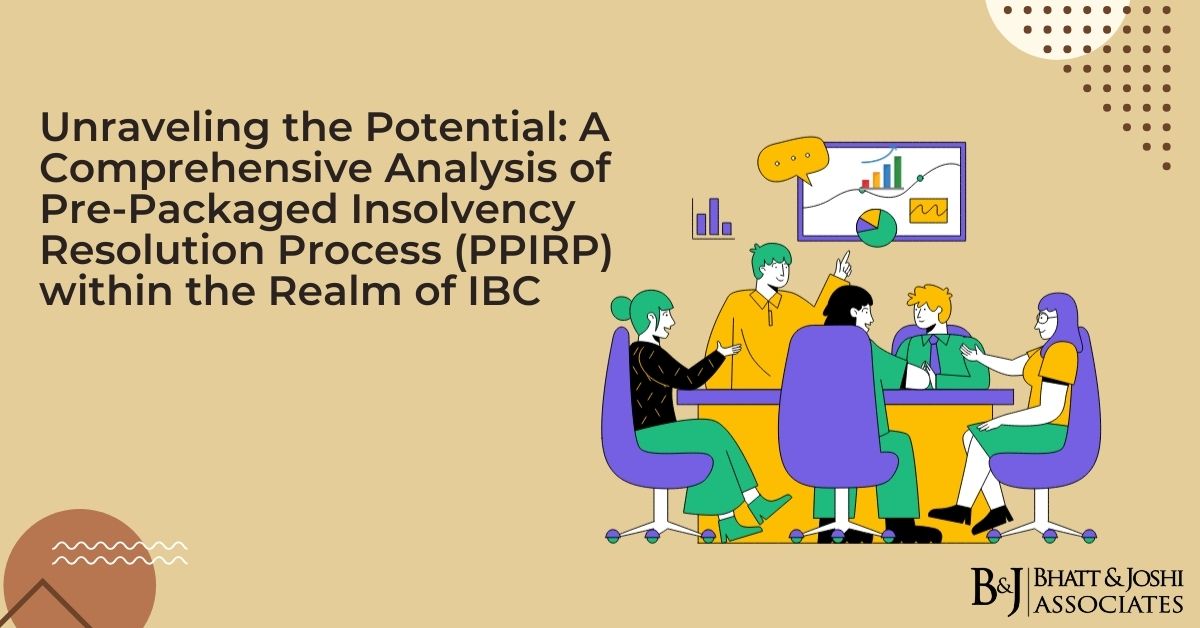Introduction
In recent years, the landscape of insolvency and bankruptcy resolution in India has undergone significant transformations, spurred by the enactment of the Insolvency and Bankruptcy Code (IBC). Among the various mechanisms introduced to bolster the efficacy and efficiency of insolvency proceedings, the Pre-Packaged Insolvency Resolution Process (PPIRP) stands out as a promising avenue for expeditious resolution, particularly tailored to address the unique challenges faced by Micro, Small, and Medium Enterprises (MSMEs) amidst the backdrop of the COVID-19 pandemic.
Introduction to Pre-Packaged Insolvency Resolution Process (PPIRP):
The Pre-Packaged Insolvency Resolution Process (PPIRP) represents a proactive approach towards insolvency resolution, premised on the notion of pre-negotiated resolution plans between financially distressed companies and their creditors. Instituted as a distinct chapter within the IBC framework, PPIRP delineates a structured mechanism for the submission, endorsement, and implementation of pre-packaged plans, thereby expediting the resolution process while safeguarding the interests of all stakeholders involved.
Understanding the Legal Framework of Pre-Packaged Insolvency Resolution Process:
A comprehensive understanding of the legal framework governing PPIRP is imperative to discern its operational dynamics and procedural intricacies. Sections 54A to 54M of the IBC, introduced through a series of amendments, serve as the bedrock of PPIRP implementation. These sections outline eligibility criteria, procedural requirements, and regulatory mechanisms governing the initiation, approval, and execution of pre-packaged resolution plans. Key provisions include provisions for base resolution plan formulation (Section 54B), insolvency professional appointment (Section 54C), and plan implementation (Section 54G), among others.
Differentiating PPIRP from Conventional Insolvency Resolution Mechanisms:
Contrasting PPIRP with traditional Corporate Insolvency Resolution Process (CIRP) elucidates fundamental disparities in objectives, procedures, timelines, and stakeholder roles. While CIRP prioritizes asset maximization and broader insolvency resolution, PPIRP underscores the significance of pre-negotiated plans in expediting restructuring efforts and mitigating financial distress. By streamlining administrative processes and fostering creditor collaboration, PPIRP offers a viable alternative to conventional insolvency resolution mechanisms, particularly for MSMEs grappling with the adverse effects of the pandemic-induced economic downturn.
Analyzing the Benefits of Pre-Packaged Insolvency Resolution Process:
The benefits accrued from adopting PPIRP as a preferred mechanism for insolvency resolution are manifold. From time and cost efficiency to enhanced creditor participation and asset preservation, PPIRP offers a myriad of advantages that resonate with the evolving needs of today’s dynamic business landscape. By facilitating swift resolution, minimizing asset erosion, and fostering stakeholder engagement, PPIRP emerges as a potent tool for revitalizing financially distressed entities and steering them towards sustainable recovery.
Exploring Landmark Cases and their Implications:
Examining landmark cases wherein PPIRP has been successfully deployed provides valuable insights into its efficacy and applicability in real-world scenarios. By analyzing notable cases such as the resolution of Ruchi Soya Industries Limited’s insolvency, stakeholders can glean valuable lessons regarding the practical implementation and impact of PPIRP on corporate restructuring efforts. Moreover, such case studies serve as catalysts for informed decision-making and policy formulation aimed at optimizing the PPIRP framework for future endeavors.
Proposing Suggestions for Enhancing PPIRP Efficacy:
In light of the evolving landscape of insolvency resolution, it is imperative to proactively identify areas for improvement and refinement within the PPIRP framework. Suggestions ranging from educational initiatives aimed at MSMEs to reevaluation of connected person prohibitions underscore the importance of adaptive policymaking and stakeholder engagement in fostering a conducive environment for PPIRP adoption and implementation. By soliciting feedback, fostering collaboration, and embracing a culture of continuous improvement, policymakers can ensure that PPIRP remains a robust and responsive mechanism for addressing the evolving needs of the business ecosystem.
Conclusion:
The Pre-Packaged Insolvency Resolution Process (PPIRP) represents a paradigm shift in the realm of insolvency resolution, offering a potent blend of expediency, efficacy, and stakeholder engagement. By harnessing the power of pre-negotiated resolution plans, PPIRP holds the potential to usher in a new era of insolvency resolution characterized by swift turnaround times, minimized asset erosion, and enhanced stakeholder participation. However, realizing this potential necessitates concerted efforts towards education, advocacy, and procedural refinement aimed at optimizing the PPIRP framework for diverse business scenarios. Through collaborative engagement and adaptive policymaking, stakeholders can unlock the full potential of PPIRP as a transformative mechanism for revitalizing financially distressed entities and fostering sustainable economic recovery.
Expanding upon the nuanced intricacies and multifaceted implications of PPIRP within the broader landscape of insolvency resolution, this discourse aims to provide a comprehensive analysis of its potential, challenges, and opportunities for future growth and refinement. By delving deeper into the operational dynamics and regulatory framework governing PPIRP, stakeholders can gain a holistic understanding of its role in reshaping the contours of insolvency resolution in India’s dynamic business environment.














